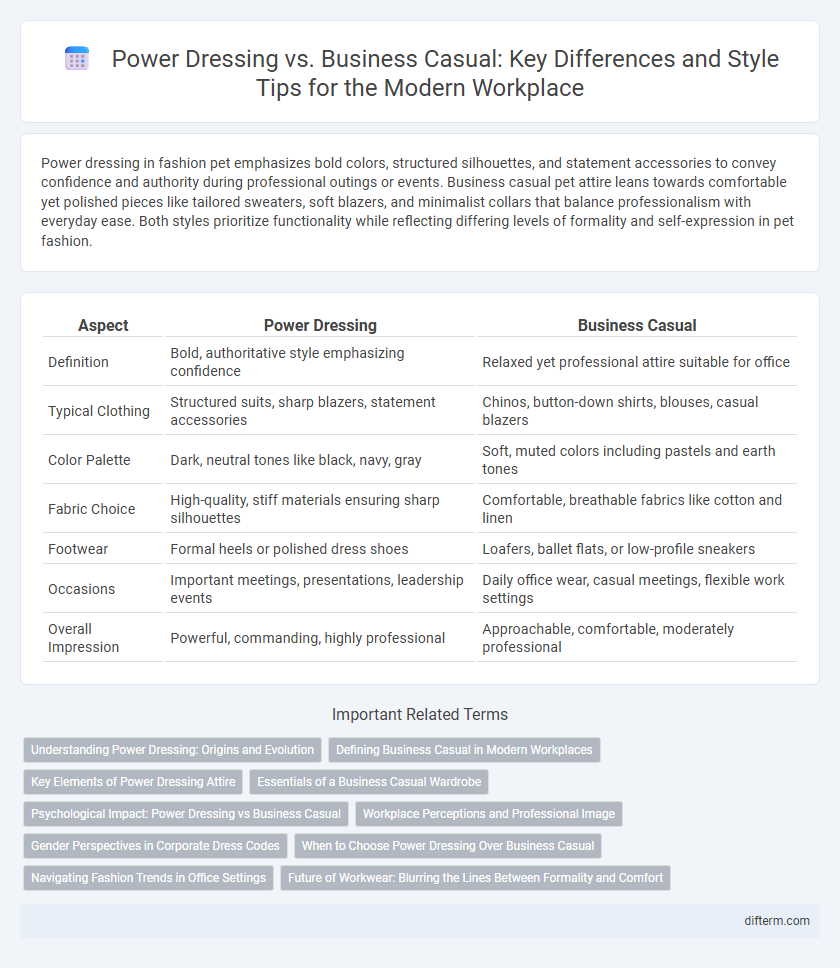Power dressing in fashion pet emphasizes bold colors, structured silhouettes, and statement accessories to convey confidence and authority during professional outings or events. Business casual pet attire leans towards comfortable yet polished pieces like tailored sweaters, soft blazers, and minimalist collars that balance professionalism with everyday ease. Both styles prioritize functionality while reflecting differing levels of formality and self-expression in pet fashion.
Table of Comparison
| Aspect | Power Dressing | Business Casual |
|---|---|---|
| Definition | Bold, authoritative style emphasizing confidence | Relaxed yet professional attire suitable for office |
| Typical Clothing | Structured suits, sharp blazers, statement accessories | Chinos, button-down shirts, blouses, casual blazers |
| Color Palette | Dark, neutral tones like black, navy, gray | Soft, muted colors including pastels and earth tones |
| Fabric Choice | High-quality, stiff materials ensuring sharp silhouettes | Comfortable, breathable fabrics like cotton and linen |
| Footwear | Formal heels or polished dress shoes | Loafers, ballet flats, or low-profile sneakers |
| Occasions | Important meetings, presentations, leadership events | Daily office wear, casual meetings, flexible work settings |
| Overall Impression | Powerful, commanding, highly professional | Approachable, comfortable, moderately professional |
Understanding Power Dressing: Origins and Evolution
Power dressing originated in the 1970s and 1980s as a symbol of female empowerment in corporate environments, characterized by structured silhouettes, bold colors, and sharp tailoring. The evolution of power dressing reflects a shift from rigid, formal attire to more versatile and personalized styles that maintain authority while embracing modern fashion trends. Understanding this transition highlights the impact of cultural and social changes on professional dress codes and the ongoing balance between confidence and approachability in the workplace.
Defining Business Casual in Modern Workplaces
Business casual in modern workplaces blends relaxed tailoring with polished elements, creating an effortless yet professional appearance suitable for various office environments. Typical pieces include tailored chinos, button-down shirts, blouses, and loafers, emphasizing comfort without sacrificing style. This dress code fosters a balance between formal power dressing and casual ease, promoting versatility and individual expression in professional settings.
Key Elements of Power Dressing Attire
Power dressing attire emphasizes structured silhouettes, such as tailored blazers, sharp lapels, and strong shoulder pads, to convey authority and confidence. Luxurious fabrics like silk, wool, and fine cotton, paired with minimalistic yet bold accessories such as statement watches or cufflinks, enhance the commanding presence. Color choices often include classic neutrals--black, navy, charcoal--with occasional pops of red to signify power and assertiveness in a professional setting.
Essentials of a Business Casual Wardrobe
Key essentials of a business casual wardrobe include tailored blazers, crisp button-down shirts, and versatile trousers or chinos that balance professionalism with comfort. Neutral colors such as navy, grey, black, and white form the foundation, allowing easy mixing and matching to create polished yet approachable looks. Footwear options like loafers, low heels, or clean sneakers complete the ensemble, ensuring style without sacrificing practicality.
Psychological Impact: Power Dressing vs Business Casual
Power dressing employs structured silhouettes and bold colors to convey confidence, authority, and professionalism, enhancing the wearer's perceived competence and influence in high-stakes environments. Business casual, characterized by softer fabrics and relaxed fits, fosters approachability and comfort, reducing stress and promoting collaborative interactions. Psychological studies reveal that power dressing can boost self-esteem and assertiveness, while business casual supports creativity and open communication, making each style impactful depending on workplace culture and desired impression.
Workplace Perceptions and Professional Image
Power dressing in the workplace often conveys authority and confidence through structured silhouettes, bold colors, and luxurious fabrics, reinforcing a commanding professional image. Business casual, featuring relaxed yet polished attire like tailored pants and smart blouses, promotes approachability and comfort while maintaining professionalism. Workplace perceptions shift according to dress codes, where power dressing may enhance leadership presence and business casual supports collaboration and inclusivity.
Gender Perspectives in Corporate Dress Codes
Power dressing often emphasizes structured suits and bold colors that convey authority, predominantly designed with masculine silhouettes in mind, while business casual embraces softer lines and more diverse fabrics that appeal across genders. Corporate dress codes are evolving to recognize non-binary and female professionals who challenge traditional norms, promoting inclusivity and flexibility in attire choices. Gender perspectives shape how organizations balance professionalism with individuality, reflecting broader cultural shifts toward gender equality in the workplace.
When to Choose Power Dressing Over Business Casual
Power dressing is ideal for high-stakes meetings, presentations, or networking events where projecting confidence and authority is essential. Business casual suits less formal environments such as daily office work, team collaborations, or casual client interactions, balancing professionalism with comfort. Choosing power dressing enhances your presence and helps make a memorable impression during critical opportunities in the corporate world.
Navigating Fashion Trends in Office Settings
Power dressing in office settings emphasizes structured silhouettes, bold colors, and statement accessories to convey authority and confidence, aligning with traditional corporate environments. Business casual prioritizes comfort and versatility, incorporating softer fabrics, relaxed fits, and neutral palettes to balance professionalism with personal style. Navigating fashion trends requires understanding the company culture, adapting key elements of both styles, and integrating seasonal updates like sustainable fabrics or minimalist designs to maintain relevance.
Future of Workwear: Blurring the Lines Between Formality and Comfort
Power dressing in the future of workwear merges sharp tailoring with adaptive fabrics, redefining formal attire to prioritize both authority and comfort. Business casual evolves by integrating sustainable materials and versatile silhouettes that transition seamlessly from office to remote settings. This convergence reflects a shift toward functional, stylish ensembles that balance professionalism with the demands of modern work environments.
power dressing vs business casual Infographic

 difterm.com
difterm.com